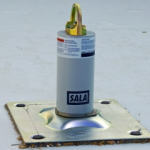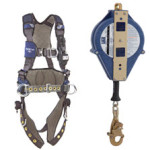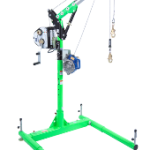The ABCD’s of Fall Arrest Systems
What are the ABCD's of fall arrest systems?
For years, folks in the fall protection industry have preached the ABCD’s of personal fall arrest systems: Anchorage, Body support, Connecting devices, and Descent and rescue. This is a great start because the approach has us thinking systematically. The phrase is easy to remember, and it prompts workers and EHS managers to think about fall arrest systems in a holistic manner, but is this enough to guarantee the safety of your employees?
Most articles and videos found on the web reference the ABC’s of fall arrest systems, and as previously mentioned, anchorage, body support, and connecting devices are important components of a fall arrest system. Let’s begin with some basic working definitions of these terms:
Anchors are used to attach horizontal or vertical lifelines, lanyards, or other fall arrest equipment to structural members. The specific type of anchorage best suited for your application will vary based on industry, job, type of installation and available structure. Anchors must be designed to sustain the loads imposed during a fall and provide a sufficient factor of safety. Remember, anchorage devices take two forms: off the shelf, stock and or/ improvised solutions and engineered or certified anchorage devices. Non-engineered systems must be rated at 5,000 lbs. per employee while engineered systems must be rated at 2 times the applied load (also referred to as a safety factor of 2) in the event of a fall.
Body Support typically takes the form of a full body harness which evenly distributes fall forces over your upper thighs, pelvis, chest and shoulders. Body harnesses provide a connection point, sometimes known as a dorsal D-Ring that attaches to your connecting device.
Your Connecting Device ties your body harness to the anchorage point. Commonly used connecting devices include shock absorbing lanyards and self-retracting lifelines (SRL’s). In the event of a fall, the braking mechanism inside the SRL engages, typically within 3 feet, dramatically reducing the actual fall distance and the likelihood of a swing fall.
Explained in this manner, it is easy to see why some might think that the ABC’s of fall arrest systems will ensure worker safety, but there is a fourth factor needed to complete the system: the Descent, Rescue, and Retrieval of a fallen worker. It is imperative to have a rescue plan in place at your jobsite in the event of a fall. All too often, folks think that calling 911 is an acceptable solution, but your employees need the necessary tools, training, and skills to execute a safe rescue. Relying solely on your local EMS may put employees’ lives in serious peril.
An effective rescue plan needs to safe and simple as possible, putting the fewest workers at risk. Think of rescue options in terms of a hierarchy—some techniques pose more dangers than others, meaning they should only be utilized as a last resort. There are four basic rescue outlined below reflect the safe rescue hierarchy as the techniques grow in complexity list and risk as you work down the list:
- Self-Rescue: A worker climbs or pulls himself to safety
- Assisted Self-Rescue: A co-worker brings a ladder, allowing the fallen employee to safely descend after a fall
- Mechanically Aided Rescue: A lift or bucket truck is used to extract a worker after a fall. Please note: this option can be dangerous in large work areas since it may take significant time to move and position the equipment in order to execute a rescue after a fall.
- Rescue Pick-Offs: This last resort measure requires considerable time and skill to execute a safe rescue. A rescue pick-off requires an additional employee or EMS officer to lower a fallen worker to safety.
As you can see from the above list, assessing the rescue situation in the event of a fall requires calm thinking and a clearly defined plan to safeguard the safety of all parties to a rescue. Your employees need to have training in advance of a fall so they can quickly and safely execute a rescue; waiting until an accident occurs is too late.
With the proper equipment, training, and skills, your employees can quickly assess the situation and utilize the safest approach to rescue a fallen co-worker. Remember, an effective fall arrest system is comprised of ABCD. To learn more about fall protection, or to discuss your specific safety requirements, contact Diversified Fall Protection for a no-obligation consultation.
Schedule an assessment with Diversified Fall Protection
Contact Us to request a fall safety review

b-1.jpg?width=1368&height=1340&name=Rail%20(175)b-1.jpg)




